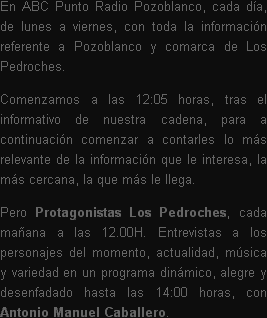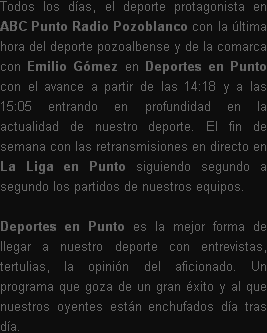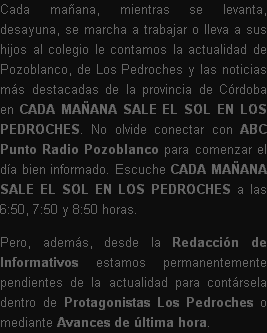Con esta medida, la concejalía ha querido dar un paso hacia delante y adaptarse a las necesidades del sector turístico. Así, se puede encontrar en inglés información referente a las guías turísticas que se ofrecen desde la Oficina Municipal de Turismo, los destinos turísticos más destacados de nuestra localidad, los alojamientos de la misma o datos sobre la gastronomía de la zona.

www.pozoblanco.es/turismo/touris-info
POZOBLANCO HISTORY
Between hypothesis and tradition it comes the true history of Pozoblanco . Without many references to ancient times, just according to tradition, it is maintained the idea that Pozoblanco has its origin in the settlement that people coming from the close village of Pedroche made in this place known nowadays as Pozoblanco, due to the epidemic plague of the Middle Ages. This traditional hypothesis leads to the conclusión that Pozoblanco born around 1350, though the historical proofs to that fact do not exist.,and also there were another epidemia by those dates. In the Pastures Arrangement made by Philip the Second in 1375, Pozoblanco is not mentioned among the populated groups of this area. Nevertheless, this fact cannot be taken as a proof of the birth of Pozoblanco, because for long time, Pozoblanco was considered as a Pedroche dependent village.
In 1425 is when it appears the first written mention about Pozoblanco. This is a document which is preserved in the Córdoba Municipal Archive. It is in 1478 when Pozoblanco gets the “village” condition, and the first idea of Pozoblanco is that of a settlement formed around the old well. The first known census is dated in 1530. By this year, 491 inhabitants. During the Modern Age, Pozoblanco was one of the Seven Villages of the Pedroches, being it a royal village. But during the years 1600 and 1747, Pozoblanco was sold by Philip the Fourth, and it became part of the El Carpio Marquessdom. As a Royal village it deppended on Córdoba, which was the town that gave the justices and appointed the Municipal Offices. By these years, Pozoblanco was gaining more importance in relation to the other villages around. This was pretty evident in the growing population, which was triplicated, from the 491 inhabitants to the 1431 in 1790. Pozoblanco got the capitality of the Seven Villages, as well as became the capital city of the Northern Old Córdoba Reign, when the police magistrate moved in 1771 from Torremilano to Pozoblanco.
The economy by these times was based on agriculture and lifestock farming.These sectors brought together the 80% of the working population. Cereals were the main cultivation, and sheeps, goats and pork, in farming. It has to be stressed that the textile sector was very important in Pozoblanco during the XVIth and XVIIth centuries.
In the XVIIIth century, Pozoblanco still has a textile industry able to diversify the economic dependence on farming and agriculture. The cloth material factory gave work to many inhabitants in Pozoblanco. Nevertheless, in the first third of the XIXth century, Pozoblanco became infected by the catrastophic carácter of those years. Epidemic cycles, a devasting famine, political inestability, and bandits also shook Pozoblanco.
During the First Republic, Pozoblanco knows one of the social uprising manifesgtations more infuriated of its history. Demands, such as the distribution of the rockrose, found a energical action in the union actions. An example of this strength is found in 1919 with the abolition of the unpopular tax of compsumtion thanks to the important strike the union maintained .
Following history, Pozoblanco took part in the Civil War in 1936. 19th July the Guardia Civil troops took up the Town Hall, seized all the material, and made intimidation patrols around the urban centre. The labour movements tried to reorganize their strengths in La Morra, though finally the republican army regained the town. In 1937, during the so called Battle of Pozoblanco (March, April), the republican army showed an inusual resistance capacity.
Nowadays, Pozoblanco has seen extrapolated that importance as a village, and it is now the head of the Valle de los Pedroches Region, being a town in constant growth, in spite of the opposite tendency in many villages and small towns around and in all the Cordoba province.









